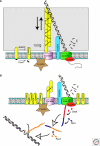Membrane-associated DNA transport machines
- PMID: 20573715
- PMCID: PMC2890206
- DOI: 10.1101/cshperspect.a000406
Membrane-associated DNA transport machines
Abstract
DNA pumps play important roles in bacteria during cell division and during the transfer of genetic material by conjugation and transformation. The FtsK/SpoIIIE proteins carry out the translocation of double-stranded DNA to ensure complete chromosome segregation during cell division. In contrast, the complex molecular machines that mediate conjugation and genetic transformation drive the transport of single stranded DNA. The transformation machine also processes this internalized DNA and mediates its recombination with the resident chromosome during and after uptake, whereas the conjugation apparatus processes DNA before transfer. This article reviews these three types of DNA pumps, with attention to what is understood of their molecular mechanisms, their energetics and their cellular localizations.
Figures




Similar articles
-
The conjugative DNA-transfer apparatus of Streptomyces.Int J Med Microbiol. 2015 Feb;305(2):224-9. doi: 10.1016/j.ijmm.2014.12.020. Epub 2014 Dec 24. Int J Med Microbiol. 2015. PMID: 25592263 Review.
-
DNA transport in bacteria.Nat Rev Mol Cell Biol. 2001 Jul;2(7):538-45. doi: 10.1038/35080005. Nat Rev Mol Cell Biol. 2001. PMID: 11433368 Review.
-
The ATPase SpoIIIE transports DNA across fused septal membranes during sporulation in Bacillus subtilis.Cell. 2007 Dec 28;131(7):1301-12. doi: 10.1016/j.cell.2007.11.009. Cell. 2007. PMID: 18160039 Free PMC article.
-
The Bacillus subtilis SftA (YtpS) and SpoIIIE DNA translocases play distinct roles in growing cells to ensure faithful chromosome partitioning.Mol Microbiol. 2009 Nov;74(4):790-809. doi: 10.1111/j.1365-2958.2009.06893.x. Epub 2009 Sep 28. Mol Microbiol. 2009. PMID: 19788545
-
Recruitment, assembly, and molecular architecture of the SpoIIIE DNA pump revealed by superresolution microscopy.PLoS Biol. 2013;11(5):e1001557. doi: 10.1371/journal.pbio.1001557. Epub 2013 May 7. PLoS Biol. 2013. PMID: 23667326 Free PMC article.
Cited by
-
A type IV pilus mediates DNA binding during natural transformation in Streptococcus pneumoniae.PLoS Pathog. 2013;9(6):e1003473. doi: 10.1371/journal.ppat.1003473. Epub 2013 Jun 27. PLoS Pathog. 2013. PMID: 23825953 Free PMC article.
-
The cell pole: the site of cross talk between the DNA uptake and genetic recombination machinery.Crit Rev Biochem Mol Biol. 2012 Nov-Dec;47(6):531-55. doi: 10.3109/10409238.2012.729562. Epub 2012 Oct 9. Crit Rev Biochem Mol Biol. 2012. PMID: 23046409 Free PMC article. Review.
-
Escherichia coli Can Eat DNA as an Excellent Nitrogen Source to Grow Quickly.Front Microbiol. 2022 Jun 28;13:894849. doi: 10.3389/fmicb.2022.894849. eCollection 2022. Front Microbiol. 2022. PMID: 35836416 Free PMC article.
-
Biological and Structural Diversity of Type IV Secretion Systems.Microbiol Spectr. 2019 Mar;7(2):10.1128/microbiolspec.psib-0012-2018. doi: 10.1128/microbiolspec.PSIB-0012-2018. Microbiol Spectr. 2019. PMID: 30953428 Free PMC article. Review.
-
Common mechanisms of DNA translocation motors in bacteria and viruses using one-way revolution mechanism without rotation.Biotechnol Adv. 2014 Jul-Aug;32(4):853-72. doi: 10.1016/j.biotechadv.2014.01.006. Biotechnol Adv. 2014. PMID: 24913057 Free PMC article. Review.
References
-
- Ausmees N, Wahlstedt H, Bagchi S, Elliot MA, Buttner MJ, Flardh K 2007. SmeA, a small membrane protein with multiple functions in Streptomyces sporulation including targeting of a SpoIIIE/FtsK-like protein to cell division septa. Mol Microbiol 65:1458–1473 - PubMed
-
- Aussel L, Barre FX, Aroyo M, Stasiak A, Stasiak AZ, Sherratt D 2002. FtsK Is a DNA motor protein that activates chromosome dimer resolution by switching the catalytic state of the XerC and XerD recombinases. Cell 108:195–205 - PubMed
Publication types
MeSH terms
Substances
Grants and funding
LinkOut - more resources
Full Text Sources
